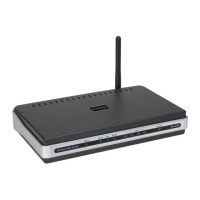Web Configuration
D-Link DSL-2640B User Manual
95
54g™ Rate: Select the transmission rate for the network. The rate of data transmission should be set depending on the speed of your wireless network. You can
select from a range of transmission speeds, or you can select Auto to have the Router automatically use the fastest possible data rate and enable the Auto-Fallback
feature. Auto-Fallback will negotiate the best possible connection speed between the Router and a wireless client. The default value is Auto.
Multicast Rate: Select the multicast transmission rate for the network. The rate of data transmission should be set depending on the speed of your wireless network.
You can select from a range of transmission speeds, or you can select Auto to have the Router automatically use the fastest possible data rate and enable the
Auto-Fallback feature. Auto-Fallback will negotiate the best possible connection speed between the Router and a wireless client. The default value is Auto.
Basic Rate: Select the basic transmission rate ability for the AP.
Fragmentation Threshold: Packets that are larger than this threshold are fragmented into multiple packets. Try to increase the fragmentation threshold if you
encounter high packet error rates. Do not set the threshold too low, since this can result in reduced networking performance.
RTS Threshold: This value should remain at its default setting of 2347.Should you encounter inconsistent data flow, only minor reductions are recommended. Should
you encounter inconsistent data flow, only minor reduction of the default value, 2347, is recommended. If a network packet is smaller than the preset RTS threshold
size, the RTS/CTS mechanism will not be enabled. The Router sends Request to Send (RTS) frames to a particular receiving station and negotiates the sending of a
data frame. After receiving an RTS, the wireless station responds with a Clear to Send (CTS) frame to acknowledge the right to begin transmission. The RTS
Threshold value should remain at its default value of 2347.
DTIM Interval:
(Delivery Traffic Indication Message) Enter a value between 1 and 255 for the Delivery Traffic Indication Message (DTIM.) A DTIM is a countdown
informing clients of the next window for listening to broadcast and multicast messages.
Beacon Interval: Beacon is a packet of information that is sent from a connected device to all other devices where it announces its availability and readiness. A
beacon interval is a period of time (sent with the beacon) before sending the beacon again. The beacon interval may be adjusted in milliseconds (ms). Default (100)
is recommended.
Global Max Clients: Default value is 16.
XPress™ Technology: Select Enable or Disable. This is a special accelerating technology for IEEE802.11g. The defaule is Disabled.
54g™ Mode: Compatible with IEEE 802.11b, IEEE 802.11g. Select a Standards from the drop-down list box. Its default setting is 54g Auto. The drop-down list box
includes below mode.
54g™ Protection: The 802.11g standards provide a protection method so 802.11g and 802.11b devices can co-exist in the same network without “speaking” at the
same time. Do not disable 54g Protection if there is a possibility that a 802.11b device may need to use your wireless network. In Auto Mode, the wireless device will
use RTS/CTS to improve 802.11g performance in mixed 802.11g/802.11b networks. Turn protection off to maximize 802.11g throughput under most conditions.
Preamble Type: Preambles are a sequence of binary bits that help the receivers synchronize and ready for receipt of a data transmission. Some older wireless
systems like 802.11b implementation use shorter preambles. If you are having difficulty connecting to an older 802.11b device, try using a short preamble. You can
select short preamble only if the 54g mode is set to 802.11b.
Transmit Power:
Adjust the transmission range here. This tool can be helpful for security purposes if you wish to limit the transmission range.
Click Apply to make the changes take effect.

